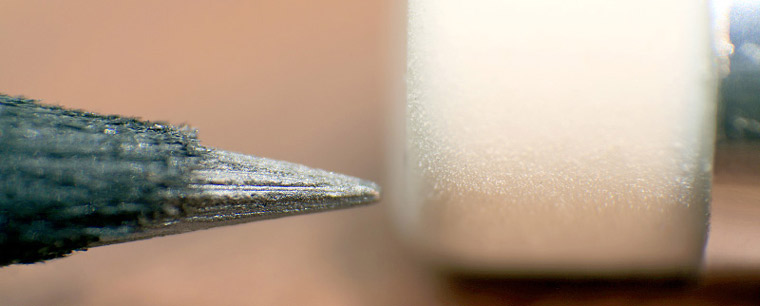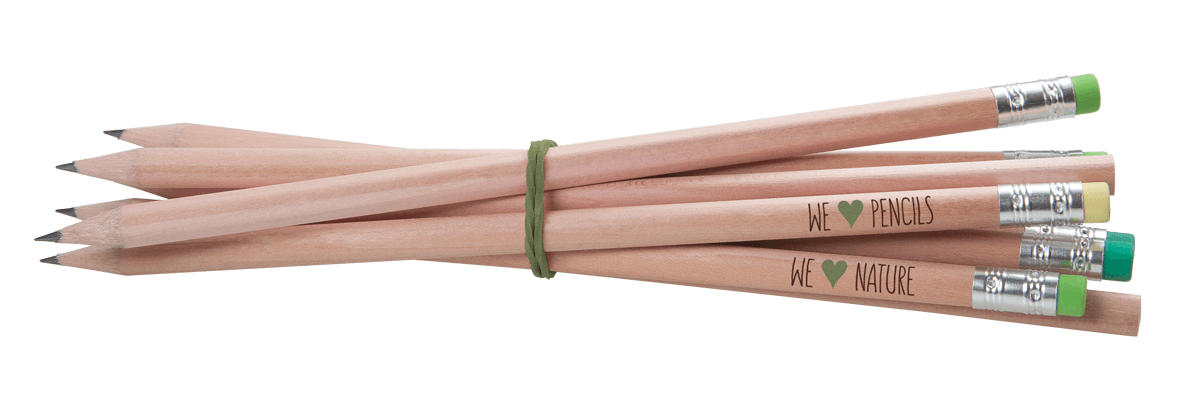The unleaded pencil.
The pencil, the classic writing instrument
A pencil is an indispensable writing and drawing tool that is used in many areas such as school, office, art and graphic design. It essentially consists of a wooden shaft (also known as a wooden casing) and a graphite core (colloquially known as a “lead” or “lead”).
Large graphite deposits were discovered in England as early as the 16th century, which was a decisive factor in the development of the pencil. Although the name “pencil” suggests that lead is used, a mixture of graphite and clay has actually been used for centuries. This mixture can be adjusted depending on the degree of hardness (e.g. from 9H - extremely hard - to 9B - very soft). This results in different line widths that are suitable for fine technical drawings, detailed sketches or bold hatching.
The pencil can be sharpened with a pencil sharpener to expose the graphite lead. An eraser makes it easy to correct mistakes, which makes the pencil particularly practical for quick notes or detailed drawings.
Thanks to its combination of sustainability, ease of use and versatility, the pencil is still one of the most popular working and creative tools today. Whether you want to buy a pencil or simply learn more about the history of the pencil, this classic writing instrument remains irreplaceable in both everyday life and the art world due to its versatility and reliability.

› Pencils (also known as graphite pencils) are writing instruments with a graphite lead embedded in a wooden shaft. They are mainly used for artistic sketching and drawing, for shorthand or for taking notes. The main advantages are that they are easy to use and can easily be removed with an eraser.
The writing ability is based on the layered crystal structure of graphite, in which the Van-der-Waals bond between the atomic layers is so weak that they can be easily rubbed off.
Pencils - indispensable helpers for everyone, whether at school, at work or in leisure time. There are pencils for all kinds of surfaces, for wood, paper, cardboard, concrete, tiles, sheet metal, wet wood or polystyrene.
History of the pencil
Where does the pencil come from?
The ancient Egyptians are said to have poured molten lead into reeds, bamboo cane or papyrus cane and used them as writing tools around 5000 years ago.
From the 12th century onwards, lead alloy styluses with silver soldered to the tip were used for writing. Pressed into pencil form, these silver pens were also used by many artists of later centuries for rough sketches.
It is said that graphite sticks were occasionally used for writing as early as the 16th century.
As early as the sixties of the 17th century, graphite sticks made of Borrowdale graphite and set in wood were used in many countries.
Finally, in 1662, a »pencil maker«, a certain Friedrich Staedtler, was recorded for the first time in Nuremberg council documents.
The pencil lead
How much lead is in the pencil lead?
The term »pencil lead« is fundamentally wrong, because the graphite pencil, as it is correctly called, does not contain any lead.
At the time, graphite was thought to be lead ore, from which the misleading name pencil is derived.
Production and ingredients
How are pencil leads made and what are they made of?
Graphite and clay are the two main raw materials from which the graphite lead is made. Both materials must be very fine and homogeneous in order to guarantee good quality. To achieve this, graphite and clay are ground very finely and the resulting ground material is mixed together. Different mixing ratios of clay and graphite result in different hardness levels. If a high proportion of graphite is used, the result is a soft lead; if a high proportion of clay is used, the lead is harder. Firing heat and firing time also have an influence on the final hardness.
The resulting mixture is pressed through a mold into a mini strand, cut to the appropriate length and then the leads are baked at very high temperatures. The final lead is then finished with wax to ensure smooth abrasion.
![[Translate to English:] Bleistift-Herstellung. Vom Brettchen bis zum fertigen Stift [Translate to English:] Wie wird ein Bleistift hergestellt?](/fileadmin/user_upload/Grafiken/Bleistifte-Herstellung-Reidinger.png)
(1) Evenly sized boards are cut from the wood. (2) Grooves for the leads are cut into the boards and glue is applied. (3) The leads are inserted and a second board is added from above. (4) The "sandwich" is pressed and dried. (5) The desired shape of the pencils is milled from the finished sandwich. (6) The finished raw pencils can now be painted, sharpened and printed!
Degrees of hardness of the lead
Pencil hardness levels / hardness labeling
The best-known hardness levels for pencils are the designations from 9H (extremely hard) to 9B (particularly soft).
B = Black; H = Hard; HB = Hard Black = medium hard; F = Firm
As the degree of hardness of pencils has never been standardized, there are 3 major standard HB values. In Japan, for example, the HB hardness corresponds to “soft”, in Europe to “medium” and in the USA to “hard” (see table).
Why you should use pencils
Pencil advantages
Why are pencils so multifunctional? The advantages of a pencil are obvious:
• Pencils are very inexpensive writing instruments
• different hardness levels for different applications (see above)
• Pencils are available everywhere and in a wide variety of designs
• Handling a pencil is very easy
• can write at any temperature and in any position (even upside down and in space!)
• Written something wrong? Made a mistake? No problem - just erase it
• Pencil writing is highly resistant to light
• Writing length up to 50,000 m!
• the sound of writing on paper and the sharpener when the blade cuts away the wood to make the blunt pencil writeable again »in the blink of an eye«
Writing length of different writing instruments
Writing length of a pencil
The writing length of different writing instruments is an important aspect that influences their efficiency, sustainability and cost-effectiveness.
However, the actual writing length can vary depending on the use and characteristics of the writing instrument.
Compared to other writing instruments, the pencil is a true master of endurance!
• Pencils: between 20.000 m and 56.000 m
• Ballpoint pens: between 1000 m and 10.000 m
• School fountain pens/fountain pens: approx. 300 m per ink cartridge. Depending on the size of the ink tank
• Rollerball: between 1000 m and 2500 m
• Gel rollerball: between 500 m and 1200 m
In a world where sustainability and economic efficiency are becoming increasingly important, the pencil is an attractive option.
Its unsurpassed writing length, coupled with its versatility and reliability, makes it an indispensable tool for writers of all kinds.
Conclusion: The superb writing length of the pencil, combined with its ecological sustainability, sends a clear message: In the world of writing instruments, the pencil remains an undefeated champion.
The experiment
Writing length of pencils
Proof of the outstanding writing length of pencils was provided by two young scientists, who won a prize in the Jugend forscht competition!
"You can draw a 56 km long line with a single pencil" (see Unnützes Wissen: 1374 skurrile Fakten, die man nie mehr vergisst, 2008)
After experimenting for a while, the two young scientists set up their experiment:
• A wheel from a teacher's physics collection
• A tripod for attaching the pencil
• A roll of paper from a supermarket checkout
• A scale to measure the pressure of the pencil on the paper
„We used a pencil to draw on a sheet of paper, which we first attached to the scales. Then we transferred the results per hundredth of a second to the PC. We used a data acquisition system called “Cassy”. We used this to determine the force exerted. Then we needed a piece of weight to press on the pencil.“
• Different pencil hardness levels
• a sharpener
The conclusion of the experiment: „The statement made in the book is far too inaccurate, too general.
How long a pencil writes depends on which pencil you use and the force with which it is being pressed [...]"
We therefore conclude that the length of the line depends on various conditions.
A soft pencil (hardness grade 8B) can be completely finished after about 20 km. However, a hard pencil can actually achieve a writing length of significantly more than 50 km.
Important for colored pencils
The production of colored leads
Colored leads consist of color pigments, fats, waxes, binders and mineral fillers such as talcum or finely ground kaolin. As with graphite lead, the quality of colored leads depends on the fineness of the ground material, but above all on the proportion and quality of the pigments. A high proportion of pigments leads to a higher quality lead and a better color spread. After blending, the mixture is also pressed through a mold into lead shape and the leads are cut to the appropriate length. Unlike graphite leads, however, colored leads are not baked but dried in drying ovens. The colored leads are also given a hot grease bath to improve their gliding properties.
To produce lead and colored pencils, grooves are first milled into two wooden boards, corresponding to the diameter of the lead. The leads are placed between the two boards and all glued together and pressed together until fully hardened. The individual pencils are then sawn and given their outer shape on planing machines: round, triangular, hexagonal or oval. The pens are then further refined, polished, lacquered in color and some are provided with lacquered caps or lacquered rings. Today, many pens are also processed unlacquered. Once the pencil is finished, it is given a company imprint, sharpened and packed in boxes or cases.
Colored lead
What is a colored pencil?
Instead of a graphite lead, the › colored pencil has a colored lead made of color pigments, fats, waxes, binders and minerals such as talcum and kaolin.
It is a writing or drawing instrument, usually with a lacquer color that matches the color of the lead.
Colored pencils are mainly used as pencils for children, as artists' materials, but also as highlighters or drawing pencils.
Unlike pencils, the lines of standard colored pencils are very difficult or impossible to erase.
Other special colored pencils are watercolor pencils, which allow subsequent coloring with water.
Special leads of the special pencils
Which leads do special pens have?
The › Graphite-/Copy pencil is a writing or drawing instrument with a water-soluble, colored lead, which is used for “document-proof” drawing.
The wooden cover is usually made of lacquered wood, as with pencils.
Carpenter pencils with a harder lead are called › Masonry pencil. Masonry pencils are used for writing on concrete or stone, in other words very hard surfaces..
A special form of carpenter's pencil is the › Multigraph pencil. This pencil has a special graphite lead that is suitable for writing on smooth surfaces such as tiles, glass, metal or even expanded polystyrene. Multigraph pencil leads are usually supplied in red, green or blue.
The different lead colors are important so that the multigraph pencil can be used for differently colored surfaces.
The multigraph pencil is also known as a giant pencil or triangular pencil. The term triangular pencil comes from the fact that the standard wooden form of the multigraph pencil is triangular. However, multigraph pencils can also be supplied with an oval wooden sleeve.
For DIY enthusiasts and on building sites
What is a carpenter pencil?
The carpenter pencil is mainly used on construction sites or in the private do-it-yourself sector for marking on materials with a rough, solid surface, such as wood, concrete or masonry.
It differs from the normal pencil in size, shape and function.
The carpenter pencil is mainly used by carpenters, bricklayers and concrete workers, as well as in the DIY sector. It is available sharpened or unsharpened on request. The carpenter pencil is usually sharpened with a sharp knife.
The standard carpenter pencil has a standardized soft lead and a rectangular cross-section, while the wooden sleeve has an oval cross-section.



![[Translate to English:] Bleistift Härtegrade Tabelle [Translate to English:] Bleistift Härtegrade Strichzeichnung mit Härtegraden von 9H bis 9B](/fileadmin/user_upload/Bleistifte/Info-Grafiken/Bleistift-Haertegrade-400px.jpg)
![[Translate to English:] Reidinger Corporate Design Logo in weiß [Translate to English:] Reidinger Logo in weiß](/fileadmin/user_upload/Grafiken/Reidinger-Logo-weiss.png)